Canine design: William Wegman surveys his shots of new and used furniture in LA

It’s been a marquee year for beloved artist William Wegman. Following two concurrent exhibitions in downtown Manhattan and the release of Abrams' William Wegman: Paintings, the artist has headed West to unveil 'William Wegman: New and Used Furniture, 1972 –2015' at Los Angeles’ Marc Selwyn Fine Art.
A captivating survey of Wegman’s use of furniture as an aesthetic and compositional apparatus, the show represents a homecoming of sorts for the East Coast artist. In the early 1970s, Wegman, then experimenting with photography and video art, became a pioneering member of the hugely influential West Coast conceptual movement that included Allen Ruppersberg, Bruce Nauman and Ed Ruscha.
Work from this fertile period appears in the 'Used' portion of the exhibition. Wegman’s early black and white images evince the playful, collaborative spirit of the times and feature the artist and friends interacting with found objects in his Santa Monica studio (now occupied by friend John Baldessari and virtually unchanged since the 1970s).
In the early days, Wegman’s material palette derived mostly from 'old furniture that happened to be kicking around the studio', as well as visual detritus collected from Southern California’s dirt-cheap thrift stores. An 81 panel work, titled Three to Four (1971–72), draws on traditional mathematic permutations in its documentation of the possible combinations of three artists engaging in four assigned activities: reading the newspaper, listening to music, drinking a soda and sitting in a chair. The piece is classic Wegman in its deft blend of humor, warmth and absurdity.
After relocating to New York in 1972, Wegman became an expert dumpster diver, retrieving furniture and other discarded objects he found interesting. Around the same time, he began regularly photographing a new kind of ‘found object’ – his beloved Weimaraner, Man Ray. Those early shots led to an iconic body of work employing the artist’s magisterial canines as subjects (he has owned ten over the years). Wegman’s dog pictures have afforded him a kind of celebrity that has grown beyond the traditional parameters of fine art.
The show’s 'New' segment places the dogs alongside and on top of iconic furniture pieces by Charles and Ray Eames and George Nakashima. Whether it’s the cheery modernity of the Eames’ shell chairs (provided by Herman Miller) or the warm humanistic quality of Nakashima’s sensual wood creations, the effect is one of unexpected harmony and playful seduction.
'Combining the Weimaraners and furniture informs them both,' notes gallerist Marc Selwyn. 'The dogs can add drama, humour and a sculptural quality to the furniture. In many cases, the shiny coats of the Weimaraners literally reflect the color and shape of the furniture, taking on dramatically different looks in various photographs.'
Wegman can never really predict how the dogs will respond to the props in question – even as they’ve evolved from curbside junk to exquisite new furniture pieces (including the contemporary American design Wegman captured for W*199, which he guest edited). 'The new work features two dogs, one which gave poise and a lot of psychology, while the other offered tremendous light and majesty,' Wegman says. The Eames shell chairs, in particular, posed unexpected difficulties for the dogs, which found holding a pose while standing on them difficult. 'Some things are inexplicably easier than others to work with. In fact, it was easier for the dogs to stand quietly on a bicycle than those particular chairs.'
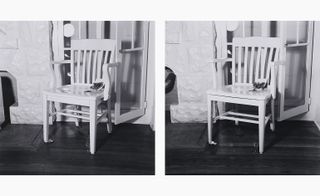
Pictured: Flipped and Switched, 1970/1999
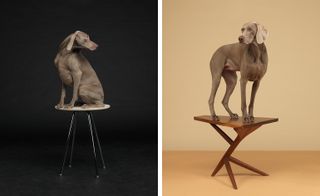
In the early 1970s, Wegman became a pioneering member of the hugely influential West Coast conceptual movement that included Allen Ruppersberg, Bruce Nauman and Ed Ruscha. Pictured left: Lit from Within, 2015. Right: 7 Legs, 2015

Pictured: Looking Over, 2015
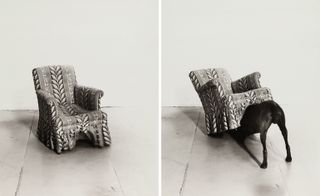
Wegman’s early black and white images evince the playful, collaborative spirit of the times and feature the artist and friends interacting with found objects in his Santa Monica studio. Pictured: So Reclined, 1971–72
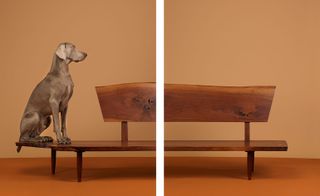
Pictured: Looking Over, 2015
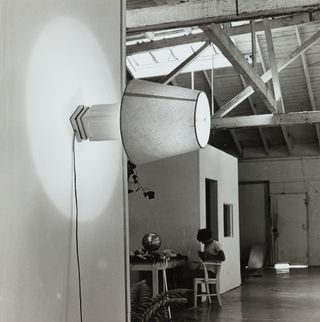
In the early days, Wegman’s material palette derived mostly from ’old furniture that happened to be kicking around the studio’, as well as visual detritus collected from Southern California’s dirt-cheap thrift stores. Pictured: A Sconce, 1972
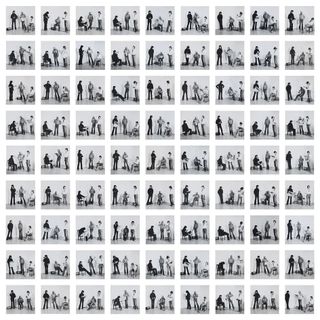
An 81 panel work titled Three to Four portrays three artists engaging in four assigned activities: reading the newspaper, listening to music, drinking a soda, and sitting in a chair. Pictured: Three to Four, 1971–72
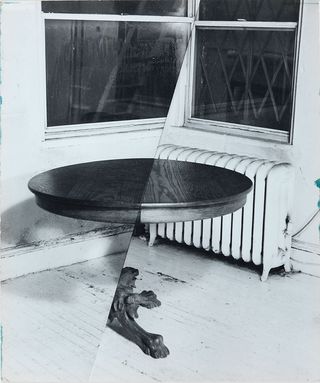
Pictured: Drop Leaf, 1974

After relocating to New York in 1972, Wegman became an expert dumpster diver, retrieving furniture and other discarded objects he found interesting. Pictured left: Eames Low, 2015. Right: Addressed, 2015
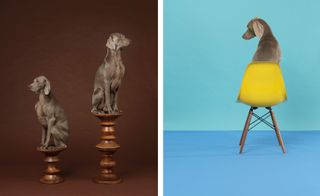
Around the same time, he began regularly photographing a new kind of ‘found object’ – his beloved Weimaraner, Man Ray. Pictured left: Pawns, 2015. Right: Ocean View, 2015

Pictured: Stop Action, 2015

Wegman’s dog pictures have afforded him a kind of celebrity that has grown beyond the traditional parameters of fine art. Pictured: Yellow Two Green, 2015
INFORMATION
’William Wegman: New and Used Furniture, 1972–2015’ is on view until 28 May. For more information, visit the Marc Selwyn Fine Art website.
William Wegman: Paintings, $45, published by Abrams. For more information, visit Abrams’ website
Photography courtesy the artist
ADDRESS
Marc Selwyn Fine Art
9953 S Santa Monica Blvd
Beverly Hills, CA 90212
Wallpaper* Newsletter
Receive our daily digest of inspiration, escapism and design stories from around the world direct to your inbox
-
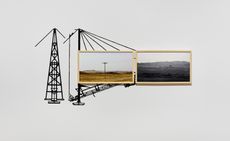 Aindrea Emelife on bringing the Nigerian Pavilion to life at the Venice Biennale 2024
Aindrea Emelife on bringing the Nigerian Pavilion to life at the Venice Biennale 2024Curator Aindrea Emelife has spearheaded a new wave of contemporary artists at the Venice Biennale’s second-ever Nigerian Pavilion. Here, she talks about what the world needs to learn about African art
By Ugonna-Ora Owoh Published
-
 All aboard: Azimut moor a yacht in the heart of Milan
All aboard: Azimut moor a yacht in the heart of MilanWith Azimut's Mooring by the Moon, Michele De Lucchi and AMDL Circle provide insight into the philsophy of the Seadeck Series with an immersive installation at Bagni Misteriosi
By Cristina Kiran Piotti Published
-
 A low-energy farmhouse provides a rural escape in North Carolina
A low-energy farmhouse provides a rural escape in North CarolinaThis low-energy farmhouse is a net zero architectural re-set for a Californian client, an East Coast relocation for a more engaged and low-key lifestyle
By Jonathan Bell Published
-
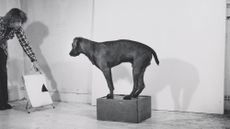 William Wegman gifts his entire short video catalogue to the Met
William Wegman gifts his entire short video catalogue to the MetBy Patricia Zohn Last updated
-
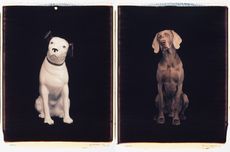 Witty and wonderful, William Wegman’s unseen Polaroids are instant classics
Witty and wonderful, William Wegman’s unseen Polaroids are instant classicsBy Charlotte Jansen Last updated
-
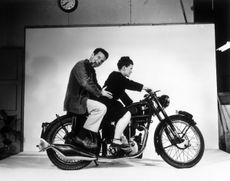 Moving pictures: MAD’s film series Midcentury Masters kicks off this month
Moving pictures: MAD’s film series Midcentury Masters kicks off this monthBy Pei-Ru Keh Last updated
-
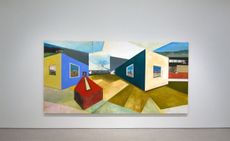 Picture postcard: William Wegman’s painterly world at Sperone Westwater
Picture postcard: William Wegman’s painterly world at Sperone WestwaterBy Brook Mason Last updated
-
 The Eames’ cinematic photography gets a moment in the spotlight at ADAM
The Eames’ cinematic photography gets a moment in the spotlight at ADAMBy Ali Morris Last updated
-
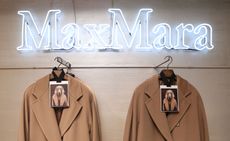 Canine connection: William Wegman’s Dogs in Coats is travelling to Max Mara boutiques across the US
Canine connection: William Wegman’s Dogs in Coats is travelling to Max Mara boutiques across the USBy Pei-Ru Keh Last updated
-
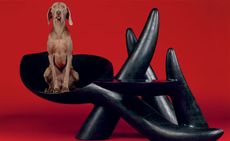 William Wegman: a profile
William Wegman: a profileA video art pioneer and conceptual photographer, we retrace Guest Editor William Wegman's career and celebrate his four-legged sitters
By Paul McCann Last updated